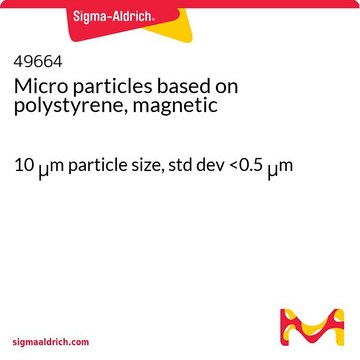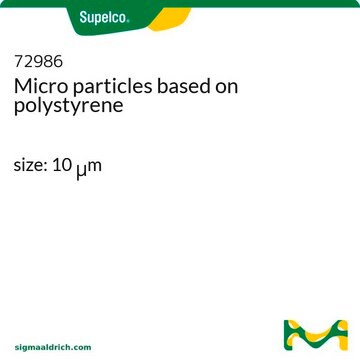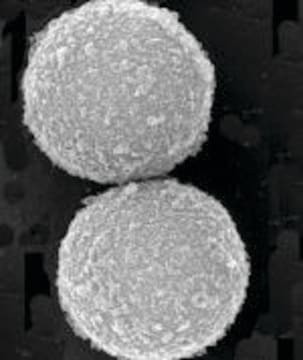08014
Micro particles, magnetic, streptavidin coated
10 μm particle size, std dev <0.5 μm
Synonym(s):
Polystyrene beads, magnetic, streptavidin coated
Sign Into View Organizational & Contract Pricing
All Photos(1)
About This Item
UNSPSC Code:
12352200
NACRES:
NA.32
Recommended Products
form
aqueous solution
Quality Level
composition
iron oxide, ≥20%
iron oxide, ≥20%
concentration
1% (solids)
particle size
10 μm std dev <0.5 μm
storage temp.
2-8°C
Looking for similar products? Visit Product Comparison Guide
General description
Micro Particles or Latex Beads, commonly known as polystyrene microparticles, are negatively charged colloidal particles. The microparticles are produced through a polymerization reaction of styrene under controlled conditions. The conducive environment of the reaction induces spontaneous coalescent bead formation. The biotin-streptavidin system is the strongest noncovalent biological interaction known, having a dissociation constant, K(d), in the order of 4x10(-14) M. The beads are magnetic in nature and coated with streptavidin for enhanced binding. Micro Particles or Latex beads are supplied in aqueous solutions composed of polymer particles with water. Polystyrene′s refractive index at 589 nm is 1.5905 and 1.602 at 486 nm.
Superparamagnetic polystyrene particles
Application
Easily conjugated with biotin, making them useful for several detection assays,.
Micro Particles or Latex Beads is used for a wide variety of applications like:
- Electron Microscopy.
- Cell Counter Calibration.
- Immunodiagnostics, especially for latex agglutination tests, and
- Phagocytosis Research.
Analysis Note
Binding capacity for FITC-Biotin: >300 pmol/mg
Storage Class Code
10 - Combustible liquids
WGK
WGK 3
Flash Point(F)
Not applicable
Flash Point(C)
Not applicable
Personal Protective Equipment
dust mask type N95 (US), Eyeshields, Gloves
Choose from one of the most recent versions:
Certificates of Analysis (COA)
Lot/Batch Number
Sorry, we don't have COAs for this product available online at this time.
If you need assistance, please contact Customer Support.
Already Own This Product?
Find documentation for the products that you have recently purchased in the Document Library.
Customers Also Viewed
Anders Holmberg et al.
Electrophoresis, 26(3), 501-510 (2005-02-04)
The biotin-streptavidin system is the strongest noncovalent biological interaction known, having a dissociation constant, K(d), in the order of 4x10(-14) M. The strength and specificity of the interaction has led it to be one of the most widely used affinity
Rongrong Huang et al.
Autophagy, 13(10), 1722-1741 (2017-08-09)
Circular RNAs are a subclass of noncoding RNAs in mammalian cells; however, whether these RNAs are involved in the regulation of astrocyte activation is largely unknown. Here, we have shown that the circular RNA HIPK2 (circHIPK2) functions as an endogenous
Our team of scientists has experience in all areas of research including Life Science, Material Science, Chemical Synthesis, Chromatography, Analytical and many others.
Contact Technical Service







